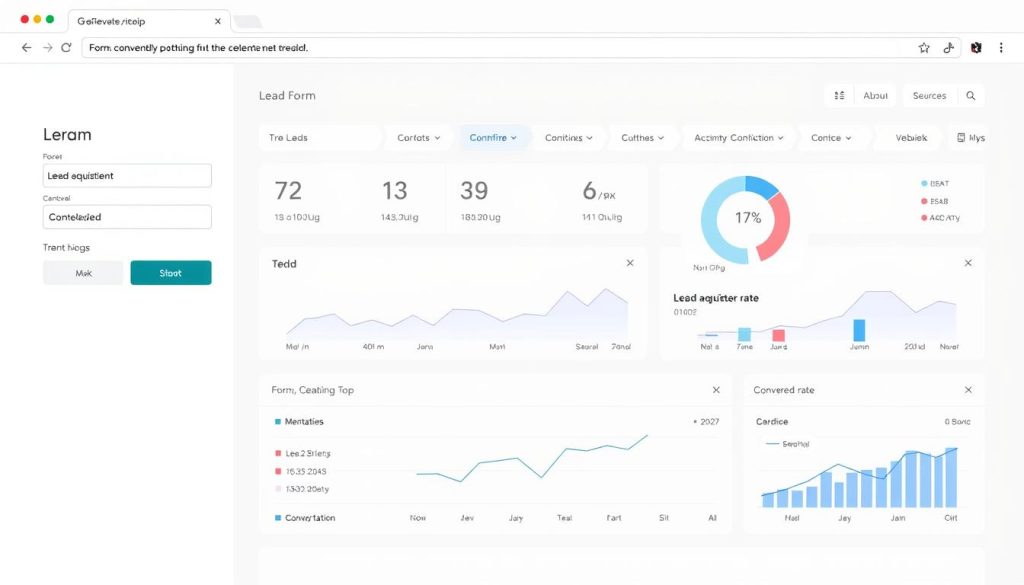In today’s digital landscape, businesses of all sizes are recognizing the critical importance of effective lead capture strategies. By automating the lead capture process online, organizations can streamline their marketing efforts, generate more qualified leads, and drive sustainable business growth. This article will explore the benefits of automated lead capture, the limitations of traditional methods, and introduce innovative solutions that can help you optimize your online lead generation efforts.
Key Takeaways
- Automated lead capture can help businesses streamline their marketing efforts and generate more qualified leads.
- Effective lead capture is essential for driving sustainable business growth in the digital age.
- Traditional lead capture methods often face limitations in terms of scalability and efficiency.
- Automated lead capture solutions offer a range of features and capabilities to optimize your online lead generation process.
- Implementing best practices for lead capture and nurturing can help you maximize the impact of your automated systems.
What is Lead Capture and Why Is It Important?
Lead capture is the process of collecting valuable contact information and data from potential customers who have expressed interest in your products or services. It’s a critical component of the sales funnel, as it allows you to identify, qualify, and nurture leads, ultimately driving more conversions and revenue for your business.
Defining Lead Capture
Lead capture refers to the process of obtaining a person’s contact information, such as their name, email address, phone number, and other relevant details, in exchange for something of value, such as a downloadable resource, a free trial, or exclusive content. This information is then used to build a database of potential customers that can be nurtured and converted into sales.
Benefits of Effective Lead Capture
Implementing a robust lead capture strategy can provide numerous benefits for your business, including:
- Increased Visibility: By offering valuable content or incentives in exchange for contact information, you can enhance your online visibility and attract more potential customers to your website.
- Improved Lead Quality: Lead capture allows you to collect information about your prospects’ interests, pain points, and stage in the buyer’s journey, enabling you to better qualify and prioritize your leads.
- Enhanced Customer Relationships: The data collected through lead capture can be used to personalize your communications and nurture leads, fostering stronger relationships and increasing the likelihood of conversion.
Effective lead capture is a fundamental component of any successful lead generation strategies and lead nurturing efforts, ultimately contributing to the overall growth and success of your business.
Traditional Lead Capture Methods: Pros and Cons
Businesses have long relied on various traditional lead capture methods, such as website forms, lead magnets, email marketing, and social media campaigns. While these approaches can be effective, they also come with their own set of limitations.
One of the primary advantages of traditional lead capture methods is their familiarity. Lead capture forms on websites have been a staple for years, allowing businesses to collect valuable information from potential customers. Similarly, lead magnets like e-books, webinars, or free trials have proven effective in exchange for contact details. Email marketing and social media lead capture campaigns also provide businesses with opportunities to reach and engage with their target audience.
However, these traditional methods also have their drawbacks. Manual data entry, lack of scalability, and limited targeting capabilities can hinder their effectiveness. Businesses often struggle to efficiently manage and nurture the leads they capture, leading to missed opportunities and wasted resources.
| Traditional Lead Capture Methods | Pros | Cons |
|---|---|---|
| Website Lead Capture Forms | Familiar, straightforward approach | Manual data entry, limited targeting |
| Lead Magnets | Effective in exchange for contact details | Resource-intensive to create and promote |
| Email Marketing Campaigns | Reach and engage target audience | Outdated contacts, low conversion rates |
| Social Media Lead Capture | Leverage social platforms to connect | Limited data and lead management |
By understanding the pros and cons of traditional lead capture methods, businesses can set the stage for exploring automated solutions that address these limitations and optimize their lead generation efforts.

Introducing Automated Lead Capture Solutions
In response to the limitations of traditional lead capture methods, a range of automated lead capture tools have emerged to streamline the process. These powerful lead capture software and lead generation platforms leverage advanced technology to capture, qualify, and nurture leads with minimal manual intervention. By exploring the different types of automated lead capture tools and understanding the key features to look for, businesses can optimize their lead capture process and drive more qualified prospects into their sales funnel.
Types of Automated Lead Capture Tools
- Website forms and pop-ups
- Chatbots and conversational interfaces
- Lead capture landing pages
- Social media lead ads
- Content upgrades and lead magnets
- CRM and marketing automation integrations
Key Features to Look for
- Intuitive form builders to create visually appealing and user-friendly lead capture forms
- Advanced targeting and segmentation to deliver personalized lead capture experiences
- Automated lead qualification based on custom criteria and scoring
- Seamless CRM and marketing automation integration to streamline lead nurturing
- Detailed analytics and reporting to optimize the lead capture funnel
| Feature | Benefit |
|---|---|
| Intelligent form builders | Create visually appealing and mobile-responsive lead capture forms |
| Audience targeting | Deliver personalized lead capture experiences based on user behavior and demographics |
| Automated lead qualification | Qualify leads based on custom criteria and route them to the appropriate sales team members |
| CRM integration | Seamlessly sync captured leads with your existing customer relationship management system |
| Reporting and analytics | Gain valuable insights to optimize your lead capture funnel and improve conversion rates |

“Automating our lead capture process has allowed us to generate more qualified leads and focus our sales team’s efforts on closing deals, not chasing leads.”
– Jane Doe, Marketing Manager at XYZ Company
Automate Lead Capture Process Online: Step-by-Step Guide
Automating your lead capture process online can be a game-changer for your business. By setting up an automated system, you can streamline your lead generation efforts and ensure a consistent flow of qualified leads into your sales pipeline. Let’s explore the key steps to get your automated lead capture system up and running.
Setting Up Your Automated Lead Capture System
The first step in automating your lead capture process is to choose the right tools for the job. Look for lead capture software that offers a user-friendly interface, customizable lead capture forms, and seamless integration with your existing marketing and sales technologies. Some popular options include HubSpot, Leadpages, and Unbounce.
Once you’ve selected your lead capture tool, it’s time to design your lead capture forms. Crafting compelling and conversion-optimized forms is crucial for effectively capturing leads. Consider incorporating eye-catching visuals, clear calls-to-action, and lead magnets or incentives to encourage form submissions.
Integrating with Your Existing Tech Stack
To ensure a smooth lead capture process, it’s important to integrate your new lead capture system with your existing marketing and sales technologies. This may include your customer relationship management (CRM) platform, email marketing software, and any other tools you use to manage your leads and customer data.
By automating the transfer of lead information between these systems, you can streamline your lead nurturing and sales processes, reducing manual data entry and ensuring that your sales team has access to the most up-to-date lead information.
| Lead Capture Automation Tool | Key Features | Pricing |
|---|---|---|
| HubSpot |
|
Free plan available, paid plans start at $45/month |
| Leadpages |
|
Paid plans start at $37/month |
| Unbounce |
|
Paid plans start at $90/month |
By following these steps, you can set up a robust and automated lead capture process that seamlessly integrates with your existing marketing and sales infrastructure. This will help you optimize your lead capture process and unlock new opportunities for growth and success.

Best Practices for Optimizing Your Automated Lead Capture
Automating your lead capture process is just the first step. To truly maximize the effectiveness of your efforts, it’s crucial to implement best practices for ongoing optimization. In this section, we’ll explore strategies for crafting compelling lead magnets that attract your target audience, as well as techniques for analyzing and refining your lead capture funnel to continually improve conversion rates and generate higher-quality leads.
Crafting Compelling Lead Magnets
The key to successful lead capture optimization lies in creating lead magnets that provide genuine value to your audience. These could be in the form of e-books, webinars, exclusive content, or even free trials. The key is to identify the pain points and needs of your target customers, and then develop lead magnets that offer a compelling solution.
- Conduct thorough market research to understand your audience’s challenges and preferences.
- Craft eye-catching and descriptive lead magnet titles that instantly capture attention.
- Ensure your lead magnets are informative, actionable, and visually appealing.
- Test different lead magnet formats to see what resonates best with your audience.
Analyzing and Refining Your Lead Capture Funnel
Ongoing lead capture funnel analysis is essential for continually improving your conversion rate optimization and generating higher-quality leads. By carefully monitoring and adjusting your lead capture process, you can optimize your landing page optimization and drive better results.
- Regularly review your lead capture funnel metrics, including opt-in rates, lead quality, and conversion rates.
- Identify any friction points or bottlenecks in your funnel and implement solutions to address them.
- Experiment with different lead capture form designs, CTAs, and landing page layouts to see what works best.
- Continuously A/B test your lead capture elements to identify the most effective approaches.
By implementing these best practices for lead magnet creation and lead capture funnel optimization, you can unlock the full potential of your automated lead capture system and generate a steady flow of high-quality leads for your business.

The Role of Lead Nurturing in Automated Lead Capture
Automated lead capture is just the first step in the customer journey. To transform those captured leads into paying customers, effective lead nurturing strategies are essential. In this section, we’ll explore the pivotal role of lead nurturing within the context of automated lead capture, delving into techniques for lead scoring, lead segmentation, and delivering personalized, relevant content to guide leads through the sales funnel.
Successful lead management hinges on the ability to nurture leads and move them closer to conversion. Automated lead nurturing empowers businesses to provide targeted, value-added content at each stage of the buyer’s journey, fostering deeper engagement and trust. By leveraging data-driven customer relationship management (CRM) tools, companies can seamlessly track lead interactions, tailor their messaging, and automate the delivery of personalized content.
Effective lead nurturing strategies often involve lead scoring, which allows businesses to prioritize leads based on their propensity to convert. By analyzing lead behaviors, demographics, and other key data points, companies can segment their leads and craft customized nurturing campaigns to address the unique needs and interests of each group.
“Lead nurturing is the process of building relationships with qualified prospects regardless of their timing to purchase, with the goal of earning their business when they are ready.” – Brian Carroll, CEO of MECLABS Institute
Ultimately, the marriage of automated lead capture and strategic lead nurturing creates a powerful framework for converting more prospects into loyal customers. By incorporating these best practices into your marketing arsenal, you can maximize the return on your automated lead generation efforts and drive sustainable business growth.
Compliance and Data Privacy Considerations
As you automate your lead capture process, it’s crucial to ensure that your practices comply with relevant laws and regulations, such as the General Data Protection Regulation (GDPR) and the CAN-SPAM Act. These data privacy regulations are designed to protect individuals’ personal information and establish clear guidelines for businesses operating in the digital landscape.
Understanding Relevant Laws and Regulations
The GDPR, which came into effect in 2018, sets strict standards for the collection, storage, and use of personal data, including email addresses and other lead information. Businesses must obtain explicit consent from individuals before capturing their data and provide clear information about how the data will be used. Failure to comply with GDPR can result in significant fines and penalties.
The CAN-SPAM Act, on the other hand, governs the sending of commercial emails in the United States. It requires businesses to include specific information in their email communications, such as a valid physical address and an easy-to-use opt-out mechanism. Violating the CAN-SPAM Act can also lead to legal consequences.
Implementing Data Privacy Best Practices
- Obtain explicit consent from leads before capturing their data
- Provide clear and transparent information about how their data will be used
- Implement secure data storage and handling procedures to protect lead information
- Offer easy-to-use opt-out options for leads who wish to unsubscribe from your communications
- Regularly review and update your data privacy policies to ensure compliance with evolving regulations
By understanding the relevant laws and regulations and implementing robust data privacy best practices, you can ensure that your automated lead capture process not only drives business growth but also upholds ethical and legal standards. This will not only protect your leads but also safeguard your business from potential legal and reputational risks.
| Regulation | Key Requirements | Penalties for Non-Compliance |
|---|---|---|
| GDPR |
|
Up to 4% of global annual revenue or €20 million, whichever is higher |
| CAN-SPAM Act |
|
Up to $43,792 per violation |
Case Studies: Businesses Succeeding with Automated Lead Capture
Automating the lead capture process has proven to be a game-changer for businesses of all sizes. Let’s dive into a few real-world case studies that showcase the power of automated lead capture and how it has helped organizations achieve remarkable lead generation success.
Take the example of SaaS startup, Acme Solutions. By implementing an automated lead capture system, they were able to streamline their lead generation efforts and improve their lead capture ROI by 35% within the first six months. The key was leveraging strategic lead capture best practices, such as creating compelling lead magnets and optimizing their lead capture funnel.
Another success story comes from Majestic Retail, a growing e-commerce brand. They were able to automate their lead capture process and saw a 45% increase in successful lead generation strategies. The implementation of automated tools allowed them to capture more qualified leads, nurture them effectively, and ultimately drive more sales-ready prospects into their pipeline.
These automated lead capture case studies demonstrate the tangible benefits that businesses can achieve by embracing this powerful approach to lead generation. From boosting lead capture ROI to streamlining the overall lead capture process, the evidence is clear: automated lead capture is a strategic investment that can unlock significant growth opportunities for organizations of all sizes.
Automate Lead Capture Process Online: Key Takeaways
As we’ve explored, automating the lead capture process online offers a wealth of benefits, from streamlining your marketing efforts to driving sustainable business growth. By harnessing the power of lead capture automation, you can enhance lead generation, nurture prospects more effectively, and ultimately boost your bottom line.
The key takeaways from our journey include the importance of implementing lead generation best practices, leveraging digital marketing automation tips, and adopting a strategic approach to lead capture automation benefits. By crafting compelling lead magnets, optimizing your lead capture funnel, and integrating your automated systems with your existing tech stack, you can unlock a powerful pathway to business success.
Remember, effective lead capture automation is not just about the technology – it’s about creating a seamless and personalized experience for your prospective customers. By prioritizing data privacy, compliance, and lead nurturing, you can build trust, foster lasting relationships, and position your business for long-term business growth strategies.




